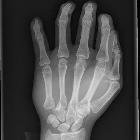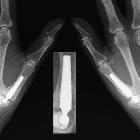carpometacarpal joint dislocation












Carpometacarpal (CMC) joint dislocations are uncommon dislocations of the hand.
Epidemiology
There is a strong younger male predominance. These injuries account for less than 1% of hand injuries and are more common in the dominant hand.
Clinical presentation
Typical mechanism:
- punching (most common)
- fall
The patient may present with ulnar deviation of the 5 digit if just the 5carpometacarpal joint is dislocated. A mass may be present in cases of 3, 4, and 5 joint dislocation. Often the hand is so grossly swollen that these features may not be readily apparent.
Radiographic features
Plain radiograph
Loss of the clear joint space and zigzag or M-shape pattern between the carpals and metacarpals on the PA projection, although this may be sometimes seen in normal patients. The dislocation may only clearly be shown on oblique or lateral projections.
Treatment
These injuries are usually unstable after reduction and therefore are managed operatively by either closed or open reduction with K-wire fixation. The K-wires are removed after 6 weeks at which time range of movement exercise begins .
Associated injuries
The following injuries should raise the suspicion of carpometacarpal joint dislocations:
- base of metacarpal fracture (common). In these cases, while the fracture does not require anatomical reduction, the carpometacarpal joint requires reduction and fixation as described above.
- hook of hamate fracture
Siehe auch:

 Assoziationen und Differentialdiagnosen zu Luxation Mittelhandknochen:
Assoziationen und Differentialdiagnosen zu Luxation Mittelhandknochen:

